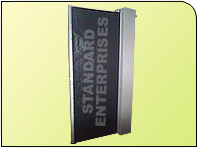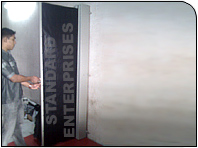Roller Covers
Roller covers are normally used where there is no space for compression & expansion length is more for Machine. This is available in P.U. Coated fabric to give better tear & abrasions resistance.
A Roller Cover is a cylindrical sleeve that fits over a paint roller frame. It's used to apply paint or another finish to walls, ceilings, and other surfaces. The material and nap (or pile) length of the roller cover can vary, and the one you choose depends on the type of paint you are using and the surface you are painting.
Standard Features of a Roller Cover :
- Material: Roller covers can be made of several different materials :
- • Synthetic : Such as nylon, polyester, or a blend. They are suitable for water-based latex paints.
- • Natural : Like lambswool or mohair, they are typically used for oil-based paints.
- Nap Length: The thickness of the nap affects how much paint the roller will hold and the type of surface it's best for :
- Short Nap (1/4 inch or less): Best for smooth surfaces like plaster, wood, or metal.
- Medium Nap (3/8 to 1/2 inch): Suitable for light-textured surfaces like walls and ceilings.
- Long Nap (3/4 inch or more): For rough surfaces like stucco or textured ceilings.
- Core : The inner part of the roller cover can be made from cardboard or plastic. A plastic core is more durable and less likely to absorb paint and moisture, which can cause a cardboard core to degrade.
- Size : Roller covers come in various sizes. The most common sizes are 9-inch and 18-inch lengths. Smaller sizes, like 3 or 4 inches, can be useful for tight spaces or detail work.
- End Type: Some roller covers have a plastic or rubberized end to reduce marks when you get close to trim or ceilings. This helps create a smoother finish.
When you are done painting, it's important to clean your roller cover thoroughly so you can use it again. If you don't plan to reuse it or if the paint has dried onto the roller, it's often more practical to discard it. Always refer to the manufacturer's recommendations for cleaning and care.
Materials used for making Roller cover:Roller covers, commonly used for painting, are made from a variety of materials to accommodate different types of paint and surfaces. The material of the roller cover affects how much paint it holds, how it releases the paint, and the texture of the finish.
Here are the main materials used for making roller covers:- Natural Fiber (Lamb's Wool or Mohair):
- • Lamb's Wool: Great for alkyd-based (oil) paints. They have excellent paint-holding capacity and tend to produce a very smooth finish.
- • Mohair: Used for applying enamel paints and varnishes. Mohair roller covers give a smooth finish.
- Synthetic Fiber : These are typically made from materials like nylon, polyester, or a blend of both.
- Nylon : Used primarily with latex paints, nylon roller covers are durable and maintain their shape.
- Polyester : Suitable for both water-based (latex) and oil-based paints, polyester roller covers are versatile and resist matting.
- Blends : Often, nylon and polyester are blended to combine the benefits of both materials. This blend is suitable for all types of paints.
- Foam :
- Great for oil-based paints, varnishes, and high-gloss coatings. Foam rollers produce a very smooth finish but might not be the best choice for rough surfaces as they can tear. They are also not recommended for latex paints as the water in the paint can cause the foam to break down.
- Microfiber :
- This is a relatively newer material for roller covers. Microfiber rollers hold more paint than other types and can deliver a very smooth finish with minimized stippling and linting. They work well with most types of paints.
- Textured or Specialty Rollers :
- These are made from various materials and are designed to create specific decorative finishes. For instance, a stucco texture might be achieved using a roller cover that has a looped or honeycomb texture.
- Core Materials :
- The core, which the nap material wraps around, is usually made of a plastic or cardboard. Professional grade roller covers often have a phenolic resin core which prevents the roller from absorbing the paint and maintains its shape even when wet.
When selecting a roller cover, it's essential to choose the right nap thickness. Nap, or pile, refers to the thickness of the roller cover. A thicker nap (like ¾ inch or 1 inch) is suitable for rough surfaces such as textured walls or ceilings. A shorter nap (like ¼ inch or ⅜ inch) is ideal for smooth surfaces, offering a finer finish.
Application industries for Roller Cover :Roller covers, often used with paint rollers, have a variety of applications across multiple industries. The type of roller cover you choose depends on the specific job, as different materials and naps (thickness of the roller cover) can yield different finishes. Here are some application industries and the typical uses of roller covers within those sectors:
- Construction and Home Improvement:
- Painting walls, ceilings, and floors
- Applying primers, stains, and sealers
- Texture coatings
- Manufacturing:
- Applying protective coatings to machinery or products
- Finish applications on products like furniture
- Automotive Industry:
- Applying protective coatings or sealants to parts
- Some large vehicle or equipment painting tasks might use rollers for broad areas, though spray is more common for a smooth finish.
- Marine Industry:
- Applying marine paints, primers, and sealants to boat hulls and structures
- Aerospace:
- While spray applications are more common for aircraft, rollers might be used for certain broad, less detail-oriented applications.
- Art and Decor:
- Creating textures on canvas or large murals
- Art installations that require broader paint application
- Agriculture:
- Applying protective coatings to equipment or structures
- Commercial and Retail:
- Painting interiors and exteriors of shops, malls, and other commercial establishments
- Maintenance tasks requiring repainting or touch-ups
- Theater and Set Design:
- Painting backdrops and large set pieces
- Flooring:
- Applying sealers, stains, or epoxies to different flooring types
When selecting a roller cover for a specific industry or application, it's important to consider the material of the cover (e.g.,synthetic fibers like nylon or polyester, natural fibers like lamb's wool, or foam), the nap length (which affects the texture of the finish), and the type of paint or coating being used (e.g., water-based, oil-based, epoxy). Different combinations are optimized for different tasks, so always ensure you are using the right roller cover for your specific application.


